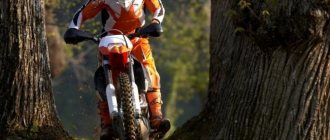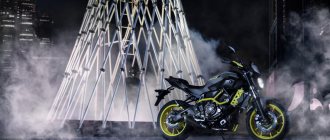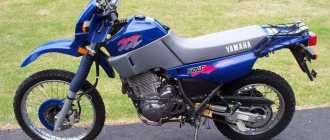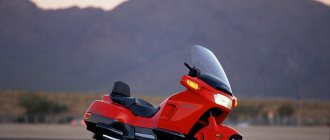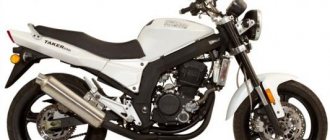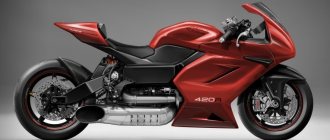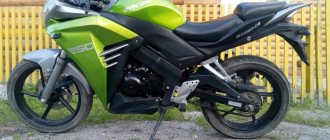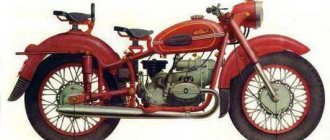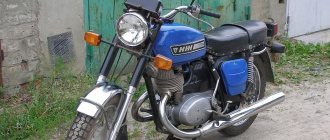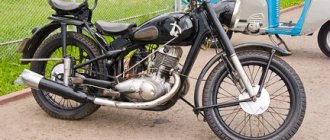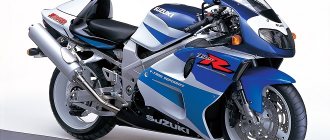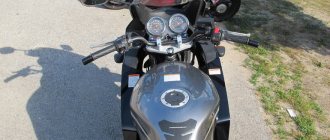We must admit that compared to most of its competitors, the KTM 690 Duke looks like an aristocrat at a party for hard workers from a nearby factory. No, we are not trying to belittle the merits of motorcycles of other brands, in no way, but the difference between the Austrian and the Japanese in this case is visible at first glance. Representatives of the Big Four of Japan rely on a combination of reliability, high technology and relatively affordable prices, but the Austrians simply do the best they can, without caring that not everyone can afford such a beauty as the KTM Duke 690. Worth it This toy is really quite a lot, but one look is enough to fall in love with it. And, most likely, this love is forever.
And it's not just a matter of style. The designers, of course, did their best for the KTM 690 Duke, but not everyone likes the angular appearance of this road bike. The main advantages of this motorcycle are hidden inside, and you understand this immediately as soon as you ride it at least once. It seems that he has been possessed by the devil, who tirelessly whispers in his head: “Come on, unscrew the right handle harder!” Explosive character combined with phenomenal handling, ergonomics thought out to the smallest detail and tenacious brakes that instantly stop the KTM Duke 690 - this is perhaps a short but very succinct description of this motorcycle. In the class of “ six hundred road builders ” he is undoubtedly the most charismatic and extraordinary representative. But the more unusual the motorcycle is, the more it differs from others, the more it is, as they say, “not for everyone.” Let us only note that the majority of motorcyclists who have had the chance to ride a KTM 690 Duke for at least ten minutes quickly fall into the category of such amateurs.
Engine
The power unit was created on the basis of the 690 Duke R, released in 2010. The development was led by Josef Mindlberger, thanks to whom the LC4 received two spark plugs with individual coils, which are controlled independently of each other by the ECU and the Drive-by-Wire throttle control system. Engine output remained unchanged - 70 horsepower and 70 Nm - but fuel consumption and emissions of harmful substances were reduced by almost 10%.
The 690cc engine featured an APTC slipper clutch and balancer shaft and was similar in design to the engine introduced a few years earlier in the Duke 690R and now found in the 690 Enduro-R and 690 SMC-R.
Test drive KTM690 Duke, KTM690 SMC
How can a small motorcycle manufacturer expand its model range without spending too much? The recipe is quite simple: you need to take the best motor available in the range (of course, suitable in terms of cubic capacity) and, using it, create the models that the factory marketers recommended. It seems to me that KTM did just that, taking as a basis their rather well-known engine with the factory designation LC4 and creating three models at once: the EXC 690 Enduro SUV, the SMC 690 supermotard and the Duke 690 road bike. A test drive of the first of this trinity was published in March issue of MD for this year, and now the time has come for the remaining two, especially since the site of the official importer of KTM in Ukraine, which was empty in winter, has been significantly replenished with new models during this time.
KTM 690 Duke
All motorcycles were presented in one place - in the south of Spain, in the resort town of Almeria. The places here are notable: the Sierra Nevada mountains lie around, and they are full of winding roads, which for the most part are with asphalt, although there are small sections without it - just what is needed for handling tests, especially SMC. Since the engine for all three models is the same, and they should still be different in nature, then with settings and some filling of the “good old LC4”, in order to give each model exactly those characteristics that suit it most. Everything turned out great with enduro and, as I already mentioned, you can read about it in the March issue of the magazine. But with the supermotard and road worker from the streetfighter clan (with the big name Duke, which means “Duke”), not everything is so simple.
"Duke"
Let's start with the first one. This brutal handsome man is the most original of the whole trinity. His appearance is aggression itself, all chopped edges, plus “unearthly” optics, and contrasting coloring in two versions adds sharpness of perception: exciting “orange with black” or even more contrasting, “white with black”. It is also configured differently from its two cousins: the frame is slightly different, the tank is in the usual place, and not under the seat, but for some reason there is no muffler at all... Although, here it is - as “compacted” as possible and hidden under motor! The solution is not new; Buell motorcycles have already sported it; moreover, taking into account the quality of Ukrainian roads and low ground clearance, it can hardly be called successful for our market. The landing, unlike enduro and motard, is super-aggressive here: the wheelbase has become a little shorter, and the handlebar-pegs-seat triangle is designed so that I, with my 186 centimeters, find myself... behind the line of the handlebars, literally hanging over the headlight. Unusual, I tell you, sensations!
But in motion the Duke, as they say, “didn’t grab me.”
An approximately two-hundred-kilometer special route was invented for it and it included: sections of small mountain roads, a decent piece of autostrada (highway) and a very small piece of city streets (no more than 5 kilometers) and having driven it, one could understand the motorcycle “from " and "before". Having started the engine, I immediately noticed the different nature of its operation and sound. I asked the KTM representatives who were present at the test, how justified are the sacrifices? (After all, by increasing the power (+2.3 hp), the designers had to fit into super-strict European emissions standards, which means losing in something else). They just threw up their hands, saying, that’s life...
What did the engine of the newly-minted “Duke” lose? Unfortunately, in many ways. Firstly, the “lower classes” have completely disappeared. Until the tachometer needle reaches the 3500 mark, you shouldn’t expect at least some adequate reaction to a jerk of the throttle, there won’t be any! Not only that, but the motorcycle can also jerk if you are forced to ride in this rev range for some time. Unlike my Russian colleagues, I had such “luck”: having missed the nearest exit from the highway, I was forced to trudge several kilometers to the hotel in fairly dense and relatively slow city traffic, either listening to the howl of the engine and trembling from vibrations in first gear , or burning the clutch with the handle half-squeezed in second. It was out of the question to even sometimes drive in 3rd gear without violating the strict Spanish city speed limit of 50 km/h! But, having reached o, the motor wakes up, and traction appears on the rear wheel, although it is still not the traction you expect. It's only when the tachometer shows you that the crankshaft has spun up to 5000 rpm that the Duke proves that it still has the right to be called a street fighter. But two points upset us: the first is the small vibrations that spread in abundance throughout its “body”, and the second is the brevity of this range, since at “8000” (the beginning of the red zone) the engine is already withering, and you can turn it, squeezing out the last juices (up to end of the red scale) makes no sense.
Otherwise - “Everything is fine, beautiful marquise!” Handling is simply superb, due to short-travel tuned suspensions, a shorter wheelbase and a different fork angle, the Duke performed “excellently” in this discipline. It’s generally impossible to find fault with the brakes, except that the rear one is a little softer than that of the SMC, but there is a radial caliper at the front, which adds information and clarity during extreme braking, which should especially appeal to those who like to perform spectacular stoppies.
In general, the purpose of this motorcycle is as follows: “lighter”. As soon as it lights up and flares up, it fulfills its function: to fill its pilot with adrenaline and delight him with extreme turns. KTM says the Duke is selling like a charm in Europe. Maybe there, with their roads, it’s for sale, I won’t argue. Although personally, it’s hard for me to imagine the utilitarian use of this beauty for traveling “to/from work” or even with a girlfriend for a country picnic …
This bike is almost identical to the Enduro 690, but is shod with 17-inch asphalt tires on Marchesini wheels and has a front brake that works more efficiently on asphalt, as well as a torque-limiting clutch.
Here, here it is, a real streetfighter for our road realities, which are still far from European ones! Yes, in appearance it seems unsightly: small 17-inch wheels on high suspensions do not add beauty. But! These same suspensions have even longer travel than those of the enduro, and also have adjustments. The latter is very useful, it means that EVERY owner, from a beginner to an advanced motardist, no matter his size, will always be able to customize them both “for himself” and for specific routes.
The engine behaves here in the same way as in enduro - it pulls quite well at the bottom, picks up very well from the middle and spins all the way to the top, practically without losing torque.
In fact, it seemed to me that it behaves somewhat more actively (I would even say more aggressively than enduro). Let me note: even with a standard muffler it sounds very “tasty”; it is obvious that they worked on tuning the latter in a special way at the factory. What's the secret? Why does the SMC 690 go “full” throughout the entire range, and the Duke only partially? After all, in principle, the engine is the same, with the same displacement and even dimensions.
It’s all about two points: the factory presets for ignition and injection, configured by the road worker for maximum environmental friendliness, and also... another rear sprocket on the “Duke”, reduced by two teeth. If the tachometer needle on the motard is not lowered below 3000 rpm, then there will always be a sufficient supply of torque under your right hand, “for a jerk” into the vacated window between the cars. And after 4000 he is ready to fly, like a falcon! Despite the long “legs”, it corners remarkably well, which is greatly facilitated by the rigid pendulum and well-functioning inverted fork. Surprisingly, for all its asceticism and seemingly excessive “long-legs,” the motorcycle is very comfortable for the pilot (except for the short one, of course) and is quite stable on straight lines, even up to a completely non-urban speed of 140-150 km/h. Of course, it’s still possible to do more, but it’s not a thrill at all. And why?
After all, this is an almost ideal “cork piercer”, a full-fledged resident of the city, he can easily storm almost any edge, is capable of driving around a dead traffic jam on grass or soil, and also going down/ascending a staircase, giving his owner complete freedom in the jungle of the metropolis. Anyone who wants can play around with it: the engine has enough power to grip the rear wheel, and the four-piston radial caliper paired with a 320 mm disc allows you to perform spectacular stoppies. Are there really no shortcomings? There are, of course: for example, vibrations in the high-speed zone, but they pale in comparison to the totality of the advantages that the KTM SMC 690 has. Anyone who understands WHAT a motard is will be able to successfully use it to conquer the urban spaces of Ukrainian cities, while receiving considerable pleasure from the degree of freedom that it provides.
Text: Valera DRIVE
Photo: author and KTM
Dashboard
Panels "Film-born" for Mattighofen: born from the Supermoto concept, it was just a motard for racing. Only five years later a class of powerful naked road motorcycles appeared.
Everything changed in 2011, after the management of the KTM plant set a task for the next five years to conquer the road motorcycle market in all available segments. Previously, the brand was positioned as a manufacturer of enduro and cross-country motorcycles, but since 2012 the plant began to produce several new products every year. Today, motorcycles of the Supersport, Naked, Adventure and Sport-Turing classes are produced under the KTM brand.
Chassis
No significant changes have been made to the chassis design, but it differs from analogues of previous models - the motorcycle’s handling when moving in a straight line has been significantly improved, which was achieved thanks to the increased fork offset in the yokes, which provided a flatter Trail of 99 millimeters. The front wheel is positioned a little further from the centerline of the steering column, which increases stability when driving in a straight line. The motorcycle does not require special repairs: with regular maintenance, it is recommended only to replace the KKTM 690 Duke pads and the opinions of experts and is achieved through more precise tuning of the electrical equipment and installation of a new exhaust system. The R version is also several horsepower more powerful, and the basic version is equipped with all systems - MSC, MTC, MSR and C-ABS. The passenger seat of the version is closed with a special cover, so it is not possible to transport a second person.
Difference in design
Motorcycle owners note their bright appearance, which attracts the attention of everyone in city traffic. One look at the KTM is enough to understand that it is an expensive model. Both models - both 690 and 690R - are almost identical in appearance, but there are certain differences.
The R version's steering wheel is painted black, and the LED turn signals are designed more elegantly than the base model. The 690 R is also equipped with crossbars that indicate the tightening torque of the fixing bolts. Both motorcycles are equipped with WP suspension, but only the Duke R model has adjustable suspension. The Brembo brake caliper caliper is more powerful on the R version. The 690R's sporty riding position is enhanced by higher-mounted footpegs that allow the bike to be tilted while riding.
Total
Many lucky riders who have had the chance to ride the KTM 690 Duke call it the perfect city bike . And there is a considerable amount of truth in this statement! Perhaps not everyone will like the character of this angular and daring Austrian, but the KTM Duke 690 does not try to please everyone at once. Expensive, very demanding on fuel quality and simply non-standard, it is, however, good in all respects. This combination of advantages is rare and for this reason alone the Duke 690 stands out among other motorcycles. And he's good. Really good.
Handling and Driving Feel
For those who have never ridden a motocross bike, the Duke will be a real discovery. The low saddle provides a flat and relaxed riding position, but on the R version it is slightly higher, but even a tall pilot will find it difficult to reach the ground. The motorcycle is narrow, but the handlebars are wide, which, coupled with its low weight, ensures ideal handling. Motorcyclists note that you can maneuver on any city street, even with the densest traffic flow. A separate advantage is the hydraulic clutch drive, which can be pressed with one finger.
KTM Duke motorcycles are memorable for their behavior and riding position. The full potential of the models is revealed in busy city traffic: the 690 and 690R have excellent maneuverability and dynamism. The motorcycle accelerates very well from a standstill, but on the highway it only picks up speed to 160, after which it somehow reaches 200 km/h, then the autopilot actually turns on. The pilot could relax, but the resistance of the headwind prevents this from happening.
On the basic version of the Duke, the brakes are more than enough for an effective and quick stop, and it is almost impossible to overheat them, but on the 690R version there are even more of them: despite the fact that the model is equipped with only one brake disc, the caliper stops the motorcycle sharply, almost completely ignoring the ABS system . The wheel is locked using the rear brake after slightly pressing the pedal.
Video Review
Specifications
| Maximum engine power: | 67 hp (49.2785 kW) HP |
| Working volume: | 690 cm3 |
| Motor type (cylinder arrangement, number of strokes): | 1C - single cylinder, 4-stroke with spark ignition and liquid cooling |
| Number of cylinders: | 1 |
| Number of valves: | |
| Intake type (Injector / Carburetor): | |
| Bore and stroke: | |
| Starting system (Electric starter, kick starter): | |
| Maximum speed in km/h: | 200 km/h |
| Cooling system: | Liquid |
| Transmission (gearbox): | Mechanical 6-speed |
| Clutch (Dry / Wet): | |
| Drive unit: | Chain |
| Frame: | Powder coated chrome steel tubular space frame |
| Chassis | |
| Suspension (front/rear travel): | |
| Brakes (Front/Rear): | |
| Wheels / Tires / Rubber: | |
| Dimensions and weight | |
| Dimensions (Length / Width): | |
| Seat height: | |
| Ground clearance: | |
| Curb weight: | |
| Wheelbase: | 1466 mm |
| Weight: | 149.5 kg |
| Fuel tank capacity: | 14 l. |
| Battery capacity: | |
| Year of release: | |
| Country of Origin: |
Engines
In terms of character and volume, the single-cylinder engine is amazing: motorcycle owners note that this is most clearly noticeable on the 690R, which is equipped with Akrapovic, which almost does not muffle the sound produced by the engine.
The engine revs up very quickly, and the motorcycle responds almost instantly to the throttle. The lower rev range is not particularly pleasing: up to 4-6 thousand, the motorcycle maintains a smooth and confident ride. All the fun begins after crossing the maximum threshold: the Duke easily accelerates to 150 km/h. Gearshifts are crisp and firm, a legacy of off-road models. Between 5th and 6th gears, you can stumble upon a false neutral if you are not confident enough to change gears.
The maximum speed of the Duke 690 is 195-200 km/h and depends on the driving skills of the driver. The engine can hardly be called economical: fuel consumption is 6-7 liters per 100 kilometers.
All options offered on the 690 R version can be installed on the base Duke 690 model by ordering them from an authorized dealer as an additional package. This feature allows you to avoid additional payments for multi-colored rims and arches by tailoring the 690 model to the characteristics of the 690R. There is no need for monobloc Brembos and custom suspension installed on a motorcycle unless the rider goes to the race track.
Pros and cons of the KTM 690 Duke
Advantages
- Low weight . Handling this motorcycle is very easy, unless, of course, you take into account its sharp reaction to turning the throttle.
- Very effective brakes and ABS system.
- Excellent handling at almost any speed, from near zero to maximum.
- Thoughtful ergonomics . All the controls are placed in such a way that the KTM 690 Duke feels comfortable to almost all bikers, regardless of their height and weight.
- The ability to fine -tune the engine “to suit you” using fuel maps.
Flaws
- High price . The KTM Duke 690 costs significantly more than many other motorcycles in the same class. The content also costs a pretty penny.
- Complex design . It is almost impossible to carry out many repair and maintenance procedures on your own, and you have to go to an official dealer, which is expensive and not always convenient.
- is too light , due to which at high speeds there is a certain lack of directional stability.
- Sluggish traction at low speeds.
